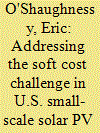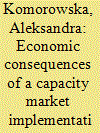|
|
|
Sort Order |
|
|
|
Items / Page
|
|
|
|
|
|
|
| Srl | Item |
| 1 |
ID:
169716


|
|
|
|
|
| Summary/Abstract |
Solar photovoltaic (PV) prices have fallen significantly over the past two decades. These price reductions have relied primarily on falling system hardware costs. Future reductions in PV prices—which are needed to ensure that enough PV will be deployed to meet global clean energy objectives—will require reductions in non-hardware or “soft” costs, particularly in markets with relatively high soft costs such as the United States. In this article, we draw insights from the literature on which factors affect soft costs for small-scale PV systems in the United States. The literature shows that soft costs tend to be lower for systems that are larger, installed during new construction, installed by more experienced installers, installed in more concentrated markets and in more competitive markets, installed in markets where customers receive more quotes, or installed in markets with less onerous permitting requirements. We identify three marketplace design strategies that policymakers could pursue to address the soft cost challenge in the United States and similar markets: encourage the expansion of quote platforms; encourage or require that PV system installation be integrated into the new construction and roof replacement process; and encourage the expansion of customer aggregation models such as Solarize campaigns and community solar.
|
|
|
|
|
|
|
|
|
|
|
|
|
|
|
|
| 2 |
ID:
096614


|
|
|
|
|
| Publication |
2010.
|
| Summary/Abstract |
This contribution analyses the European electricity markets with respect to their aptitude to absorb large amounts of wind energy. Thereby in a first step the market designs of the major European power markets in France, Germany, Scandinavia, Spain and UK are reviewed, with a particular focus on liquidity in the spot and intraday markets. Then some key features of the short-term adjustments required by wind energy are discussed and the necessity of sufficient liquidity in intraday markets is highlighted. For the example of the German market subsequently the discrepancy between the physical short-term adjustment needs and the traded volumes on the intraday market is analyzed. This leads to an evaluation of proposals for improving the liquidity on the short-term market, including the use of continuous spot trading like in UK or the use of intraday auctions like in Spain.
|
|
|
|
|
|
|
|
|
|
|
|
|
|
|
|
| 3 |
ID:
097457


|
|
|
|
|
| Publication |
2010.
|
| Summary/Abstract |
This contribution analyses the European electricity markets with respect to their aptitude to absorb large amounts of wind energy. Thereby in a first step the market designs of the major European power markets in France, Germany, Scandinavia, Spain and UK are reviewed, with a particular focus on liquidity in the spot and intraday markets. Then some key features of the short-term adjustments required by wind energy are discussed and the necessity of sufficient liquidity in intraday markets is highlighted. For the example of the German market subsequently the discrepancy between the physical short-term adjustment needs and the traded volumes on the intraday market is analyzed. This leads to an evaluation of proposals for improving the liquidity on the short-term market, including the use of continuous spot trading like in UK or the use of intraday auctions like in Spain.
|
|
|
|
|
|
|
|
|
|
|
|
|
|
|
|
| 4 |
ID:
186415


|
|
|
|
|
| Summary/Abstract |
We investigate the transmission of natural gas shocks to electricity prices under different scenarios of electricity generation for 21 European markets, from January 1, 2015 to March 11, 2022, proposing indicators of market vulnerability based on the quantile slopes of the regressions of electricity on natural gas and the distance between the transmission effects at very high and low quantiles of the electricity price distribution. We determine that the level of market integration is the main factor underlying national differentiation. Denmark, Finland, Sweden, and Germany are the most vulnerable markets to natural gas price shocks under distress. Our results highlight a source of vulnerability that only emerges during market distress scenarios for countries with a small, but non-zero, proportion of natural gas in domestic generation mixes under marginal cost-based electricity pricing. Further market integration is proposed to increase resilience in European electricity markets, based on a different set of regressions.
|
|
|
|
|
|
|
|
|
|
|
|
|
|
|
|
| 5 |
ID:
177325


|
|
|
|
|
| Summary/Abstract |
We model the evolution of the Central Western Europe power system until 2040 with an increasing carbon price and strong growth of variable renewable energy sources (vRES) for four electricity market designs: the current energy-only market, a reformed energy-only market, both also with the addition of a capacity market. Each design is modelled for two decarbonisation pathways: one targeting net-zero emissions by 2040 for a 2 °C warming limit, and the other targeting −850 Mt CO₂ y‾ for a 1.5 °C warming limit. We compare these scenarios against the high-level objectives of delivering low-carbon electricity reliably to consumers at the lowest possible cost. Our results suggest that both 2 °C and 1.5 °C compliant systems could be achieved and deliver electricity reliably. In terms of cost, we find the 1.5 °C warming scenarios lead to system costs which are twice as high as the 2 °C scenarios due to the high cost of negative emission technologies – in particular direct air carbon capture (DAC). To make a 1.5 °C target more affordable, policymakers should investigate lower cost alternatives in other sectors, and increase research and development in DAC to reduce its cost.
|
|
|
|
|
|
|
|
|
|
|
|
|
|
|
|
| 6 |
ID:
163535


|
|
|
|
|
| Summary/Abstract |
Thanks to new technological advancements and EU policy impulse, distributed energy resources (DER) are poised to become a viable alternative to conventional electricity generation for the provision of balancing services to transmission system operators. In this paper we show that the design variables that affect DER access to and participation in the organized balancing market include different features of auction configuration as well as a number of formal, administrative and technical aspects of market design. In a comparative case study of the balancing markets in Austria, Germany and the Netherlands, we determine the extent to which a given market design effectively facilitates DER participation. To structure this analysis, we designed an assessment framework that provides a comprehensive tool for the assessment of balancing markets in Europe vis-à-vis DER participation. Our results show that flexible pooling conditions, a higher bidding frequency and product resolution, and the authorization of non-precontracted bids, among others, can significantly ease DER integration in the market. Different design variables, however, can enhance or neutralize each other's effects, so their interrelations need to be taken into account in order to achieve an improved and harmonized balancing market design.
|
|
|
|
|
|
|
|
|
|
|
|
|
|
|
|
| 7 |
ID:
176859


|
|
|
|
|
| Summary/Abstract |
This paper investigates the potential economic consequences of setting up a capacity market in Poland. A computable model of the Polish power generation system is developed and employed to analyse the impact of this mechanism. Two scenarios are designed for this study: (i) a reference scenario that reflects the energy-only market and (ii) a capacity market scenario that assumes the implementation of such an instrument. To assess the economic consequences, the following parameters are estimated: (i) annual electricity prices, (ii) Loss Of Load Hours, (iii) Expected Energy Not Served, and only for the capacity market scenario: (iv) market clearing price, (v) total budget of the capacity market, and (vi) increase in electricity price due to the introduction of the capacity market. The findings of the study indicate that the long-term maintenance of the energy-only market results in higher electricity prices when compared to putting a capacity market into operation. Introducing a capacity market enables existing resources to be used effectively without excessive capital expenditure. The methods and conclusions presented in this paper provide valuable findings and policy insights regarding the potential economic consequences of a capacity mechanism in a power system mostly dominated by coal and undergoing an energy transition.
|
|
|
|
|
|
|
|
|
|
|
|
|
|
|
|
| 8 |
ID:
181437


|
|
|
|
|
| Summary/Abstract |
Auctions have recently become the most widely adopted approach globally to procure renewable energy projects. Countries starting to use auctions often struggle to secure sufficient bidder interest – resulting in limited competition levels and high project prices. Brazil, a pioneer in the use of auctions to stimulate investment in renewable energy projects, offers important lessons on not only how auctions can be designed and implemented to stimulate competition and deliver effective investment outcomes, but importantly also shows how auctions form part of the country's electricity markets and can be integrated in a country's broader institutional and policy framework to ensure long-term success. This paper presents the detailing and specifications throughout the process of contracts and auction design definition to integrate renewable energy sources (RES) into the electrical matrix, from the institutional and procedural side to policy implications of securing the revenue stream and addressing off-taker risk between the sellers and buyers of electricity sector.
|
|
|
|
|
|
|
|
|
|
|
|
|
|
|
|
| 9 |
ID:
176100


|
|
|
|
|
| Summary/Abstract |
Chile was the first country that privatized all generation, transmission, and distribution services, and introduced competition in the generation segment. Nearly four decades after its creation, many features of the original electricity market design remain unchanged. In this paper, we provide a brief history of the Chilean electricity market and explain its main limitations going forward. Some of these include the use of a cost-based mechanism for spot transactions based on a merit-order curve, low temporal granularity of spot prices, missing forward markets to settle deviations from day-ahead commitments, inefficient pricing of greenhouse gas emissions due to administrative rules, and a capacity mechanism that does not reflect a clear resource adequacy target. Many of these limitations are also present in other electricity markets in Latin America that, when privatized, mirrored many features of the electricity market design in Chile. Failing to address these limitations will provide distorted incentives for the efficient entry and operation of resources that could impart flexibility to the system, increasing the cost of decarbonizing the power sector.
|
|
|
|
|
|
|
|
|
|
|
|
|
|
|
|
| 10 |
ID:
105792


|
|
|
|
|
| Publication |
2011.
|
| Summary/Abstract |
For the large-scale integration of electricity from renewable energy sources (RES-E), the German system seems to reach its limits. In 2009, the electricity wholesale market experienced serious negative prices at times of high wind and low demand. The feed-in system in Germany consists of a fixed feed-in price, a take-off obligation and a RES priority rule, and in practice only very restrictive use of RES-E curtailment. Exactly the latter is the problem. We argue that the overall performance of the system would improve seriously by lifting the restrictions on the use of voluntary curtailment agreements, while retaining the priority rule as such. Since generators of RES-E can only improve under this system reform, investment conditions improve, leading to higher installed RES-E capacity. This in turn implies that reduced wind output due to curtailment can actually be offset by higher wind output in all periods in which there is no problem.
|
|
|
|
|
|
|
|
|
|
|
|
|
|
|
|
| 11 |
ID:
088280


|
|
|
|
|
| Publication |
2009.
|
| Summary/Abstract |
The share of microgeneration (power generation at the level of households and small businesses) in the Dutch electricity system continues to grow. Over time, this development may pose a threat to the reliability and efficiency of the Dutch electricity balancing market. We investigated possible changes to the design of the Dutch balancing market that can maintain or even improve upon its current operational performance level. The first step of the research was an analysis of the existing Dutch balancing market. It consists of three main instruments: programme responsibility, the single buyer market for regulating and reserve power (RRP), and imbalance settlement. The balancing market currently functions satisfactorily. Subsequently, the effects of large-scale development of microgeneration in the Netherlands were evaluated with a qualitative scenario analysis. Four microgeneration scenarios and two methods for allocating the household electricity consumption and generation were considered. The four scenarios concerned large-scale penetration of PV, heat-led micro CHP, electricity-led micro CHP operated by the household consumer, and electricity-led micro CHP operated by the supply company. The last scenario was found to have the strongest positive net effect. Finally, six design options were identified for improving the Dutch balancing market design in case the share of microgeneration would increase substantially. Of these six options, adjusting the profile methodology and the regulation of smart meters are no-regret options that can be implemented immediately. The attractiveness of the other options depends upon the microgeneration portfolio that emerges, the manageability of large metering data flows, and the nature of the technical effects of large-scale microgeneration penetration.
|
|
|
|
|
|
|
|
|
|
|
|
|
|
|
|
| 12 |
ID:
181436


|
|
|
|
|
| Summary/Abstract |
Electricity balancing is one of the main demanders of short-term flexibility. To improve its integration, the recent regulation of the European Union introduces a common standalone balancing energy market. It allows actors that have not participated or not been awarded in the preceding balancing capacity market to participate as voluntary bidders or ‘second-chance’ bidders. We investigate the effect of these changes on balancing market efficiency and on strategic behavior in particular, using a combination of agent-based modelling and reinforcement learning. This paper is the first to model agents' interdependent bidding strategies in the balancing capacity and energy markets with the help of two collaborative reinforcement learning algorithms. Results reveal considerable efficiency gains in the balancing energy market from the introduction of voluntary bids even in highly concentrated markets while offering a new value stream to providers of short-term flexibility. ‘Second-chance’ bidders further drive competition, reducing balancing energy costs. However, we warn that this design change is likely to shift some of the activation costs to the balancing capacity market where agents are prompted to bid more strategically in the view of lower profits from balancing energy. As it is unlikely that the balancing capacity market can be removed altogether, we recommend integrating European balancing capacity markets on par with balancing energy markets and easing prequalification requirements to ensure sufficient competition.
|
|
|
|
|
|
|
|
|
|
|
|
|
|
|
|
| 13 |
ID:
096609


|
|
|
| 14 |
ID:
168651


|
|
|
|
|
| Summary/Abstract |
Driven by the liberalization of the energy market that began in the 1990s, the European Union aims to unify its internal market and achieve price convergence among all European economies. The majority of European countries have successfully established power exchanges, aiming to conduct cross-border transactions in a transparent and reliable manner. This paper provides a comprehensive overview of prior literature on the market design of the European Power Exchanges. It also identifies recent developments in the electricity market in Greece and describes the structure of the Hellenic Energy Exchange and the markets that will be formed in the future. These upcoming markets are expected to provide greater flexibility to all market participants. At the same time, the Hellenic Energy Exchange is expected to facilitate the integration of Greece into the rest South East European electricity markets.
|
|
|
|
|
|
|
|
|
|
|
|
|
|
|
|
| 15 |
ID:
131649


|
|
|
| 16 |
ID:
176849


|
|
|
|
|
| Summary/Abstract |
The Nigeria Power sector reform was performed between the year 2010 and 2013 but it has undoubtedly been adjudged unsuccessful by most stakeholders. The failure of the reform is evidenced by a myriad of seemingly insurmountable economic, institutional, technical, financial and socio-political challenges exacerbated by the recent macroeconomic crisis. This paper performs a comparative analysis of the Nigeria reform with the “Standard model” of electricity reform to understand the root cause of the reform failures while taking cognizance of the starting conditions of Nigeria. Our result reveals that incomplete privatization coupled with the horizontal integration of the transmission and network operations, the underdeveloped gas supply infrastructure network and the ineffective/weak regulatory framework as the root problems. Thereafter, we recommended strengthening the regulatory framework as a good starting point to resolve sectoral problems. We argued that, considering the depth of the regulatory concerns, strengthening the framework will resolve the problems of investment, access and pricing and improve the overall sectoral performance (ex-post). Furthermore, we recommended the need for a workable market design and regulatory framework for decentralized solar PV generation and integration that is adaptable and nicely fits with a strengthened centralized generation framework.
|
|
|
|
|
|
|
|
|
|
|
|
|
|
|
|
| 17 |
ID:
177336


|
|
|
|
|
| Summary/Abstract |
In electricity markets around the world, the substantial increase of intermittent renewable electricity generation has intensified concerns about generation adequacy, ultimately driving the implementation of capacity remuneration mechanisms. Although formally technology-neutral, substantial barriers often exist in these mechanisms for non-conventional capacity such as electricity storage. In this article, we provide a rigorous theoretical discussion on design parameters and show that the concrete design of a capacity remuneration mechanism always creates a bias towards one technology or the other. In particular, we can identify the bundling of capacity auctions with call options and the definition of the storage capacity credit as essential drivers affecting the future technology mix as well as generation adequacy. In order to illustrate and confirm our theoretical findings, we apply an agent-based electricity market model and run a number of simulations. Our results show that electricity storage has a capacity value and should therefore be allowed to participate in any capacity remuneration mechanism. Moreover, we find the implementation of a capacity remuneration mechanism with call options and a strike price to increase the competitiveness of storages against conventional power plants. However, determining the amount of firm capacity an electricity storage unit can provide remains a challenging task.
|
|
|
|
|
|
|
|
|
|
|
|
|
|
|
|
| 18 |
ID:
150368


|
|
|
|
|
| Summary/Abstract |
We investigate the resource adequacy requirements of the PJM Interconnection, and the sensitivity of capacity procurement decisions to the choice of reliability metric used to measure resource adequacy. Assuming that plants fail independently, we find that PJM's 2010 reserve margin of 20.5% was sufficient to achieve the stated reliability standard of one loss of load event per ten years, with 0.012 expected loss of load events per year. PJM could reduce reserve margins to 13% and still achieve adequate levels of reliability as measured by the 2.4 Loss of Load Hours metric and the 0.001% Unserved Energy metric, which are used by other U.S. and international systems. A reserve margin of 13–15% would minimize long-run system costs. Reducing reserve margins from 20.5% to 13% in 2010 would have reduced PJM's capacity procurement by 11 GW, the same amount of coal capacity that PJM has identified as at high risk of retirement. We also investigate the risk posed by correlated failures among generators, a risk traditionally not modeled by system planners. We illustrate that three types of correlated failures may increase outage risks: natural gas supply disruptions, reduced reliability among generators during winter months, and the simultaneous shutdown of multiple nuclear generators for regulatory reasons.
|
|
|
|
|
|
|
|
|
|
|
|
|
|
|
|
| 19 |
ID:
149982


|
|
|
|
|
| Summary/Abstract |
The European Union took more than 20 years to start defining a common market design for its internal electricity market: a European Power Target Model. And, a further 10 years to fully implement it. Meanwhile, the reference generation set of that model has shifted from CCGT burning gas to RES plants transforming intermittent natural resources. Could the existing EU target model continue to work well for the short- term operation and long-term investment? If not, can the existing EU institutions easily produce an “RES resilient” new power target model?
|
|
|
|
|
|
|
|
|
|
|
|
|
|
|
|
| 20 |
ID:
150371


|
|
|
|
|
| Summary/Abstract |
Intraday markets for electricity allow for trading of energy until shortly before the period of delivery. This offers market participants a possibility to reduce their expected imbalances and to offer own unused flexibility. Because this form of distributed balancing before the period of delivery can be profitable for market participants as well as beneficial for system operations, intraday trading is expected to gain more importance in future, especially with increasing shares of variable renewable energy sources in the generation mix.
|
|
|
|
|
|
|
|
|
|
|
|
|
|
|
|
|
|
|
|
|